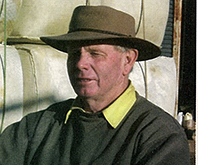Read the latest information on
Foot-and-mouth disease
 New South Wales sheep producer and 2010 Biosecurity Farmer of the Year finalist, Terry Hayes, was a pioneer of biosecurity farming practices long before he knew what the term meant.
New South Wales sheep producer and 2010 Biosecurity Farmer of the Year finalist, Terry Hayes, was a pioneer of biosecurity farming practices long before he knew what the term meant.
Over the past four decades he has been heavily involved in plant and animal health measures that have helped improve the lives and businesses of many farmers and rural communities across the country.
Being a third generation farmer on his grazing property at Middle Arm, near Goulburn in the Southern Tablelands, Terry grew-up on the land understanding his father’s fights and frustrations with ongoing rabbit control.
However, it was during the mid 1970s and 1980s that he was involved in his own biosecurity project to control hydatid disease – a serious condition carried by tapeworms causing cysts in the internal organs of humans, which can reduce the value of livestock. It is a preventable cycle caused by dogs eating offal from sheep and passing the tapeworm eggs on to people.
Terry says the successful program taught people to feed prepared food to their dogs, worm them regularly and to adopt good hygiene practices. It resulted in widespread behavioural change throughout the region, with hydatid disease virtually dropping off the radar in the Goulburn area.
Terry’s next, and most high-profile, contribution to biosecurity was his committed involvement with ovine Johne’s disease (OJD). After his flock tested positive for the disease in 1995, Terry became frustrated by the regulatory process and lack of information available to producers, and worked to find his own information, solutions and networks.
He became actively involved in a local producer group that enabled producers to talk openly, which he believes was “a very important part of the disease management process”. He was also a producer representative on the New South Wales OJD Advisory Committee. For a number of years Terry travelled extensively throughout New South Wales and to South Australia, talking with animal health experts about OJD and sharing his experience with other producers From 1998 to 2004, Terry formed an agreement with researchers from the Elizabeth Macarthur Agricultural Institute and became heavily involved with extensive trials on his property, many which can be attributed to underlying much of today’s knowledge of the disease.